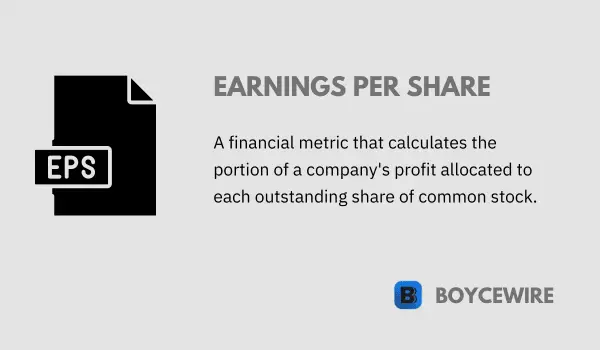Earnings Per Share: How to Calculate & Examples

What is Earnings Per Share?
Earnings Per Share (EPS) is a critical financial metric used by investors, analysts, and businesses to assess a company’s profitability and financial health. By offering a per-share profit perspective, EPS helps provide a more nuanced understanding of a company’s profitability relative to its shareholders’ equity. It allows for comparisons between different companies in the same industry, thereby acting as a tool to decide where to invest.
The power of EPS lies in its simplicity and effectiveness. It calculates the portion of a company’s profit allocated to each outstanding share of common stock, serving as an indicator of the company’s profitability. Furthermore, EPS can influence the market price of shares and is often considered while determining dividends.
Key Points
- Earnings per share (EPS) is a financial metric that indicates the profitability of a company on a per-share basis.
- It is calculated by dividing the company’s net earnings by the total number of outstanding shares.
- EPS is commonly used by investors and analysts to assess a company’s profitability and compare it with other companies in the same industry.
Understanding Earnings Per Share (EPS)
Earnings per Share (EPS) is a financial metric that divides a company’s net income by the number of outstanding shares of its common stock. In simpler terms, it represents the portion of a company’s profit that would be distributed to each share if the company decided to distribute all of its earnings.
Expressed as a per-share value, EPS offers a standardized way of looking at a company’s profit, which is especially useful when comparing the profitability of different companies. EPS is a key part of the price-to-earnings (P/E) valuation ratio, with the E representing EPS in the ratio. The P/E ratio is a significant tool investors use to determine the relative value of a company’s shares.
There are different types of EPS – basic and diluted. Basic EPS does not account for dilution – the reduction in earnings per share or the increase in the number of shares due to potential sources like stock options, convertible securities, or additional shares. On the other hand, diluted EPS factors in potential dilution, thus providing a conservative figure for EPS.
EPS is also crucial in the calculation of dividends. Many companies pay a portion of their earnings as dividends, and EPS can help determine the dividend per share.
Overall, understanding EPS is critical for both businesses and investors. For businesses, it provides insights into their financial performance and helps in strategizing future financial decisions. For investors, EPS aids in analyzing the profitability and potential for future growth of companies, aiding in investment decisions.
Types of Earnings Per Share (EPS)
There are primarily two types of Earnings per Share (EPS) that analysts and investors look at: Basic EPS and Diluted EPS.
-
Basic EPS
This is the most straightforward type of EPS. It is calculated by dividing the net income of the company (earnings) by the number of outstanding shares of common stock. Basic EPS does not consider any company securities that could potentially be converted into common stock shares.
Calculation: Basic EPS = Net Income / Number of Outstanding Shares
-
Diluted EPS
This is a more conservative measure of EPS that includes the potential dilution that could occur if all convertible securities were exercised. Convertible securities are financial instruments like stock options, convertible bonds, convertible preferred shares, etc., that can be converted into common stock. When these securities are converted into common stock, it increases the number of outstanding shares, thereby diluting the earnings per share.
Calculation: Diluted EPS = (Net Income + Convertible Securities) / (Number of Outstanding Shares + Additional Shares from Convertible Securities)
The choice between basic and diluted EPS can affect investor perception. Basic EPS may present a more optimistic picture of a company’s profitability, while diluted EPS may provide a more conservative, worst-case scenario. Both types are important for a comprehensive understanding of a company’s earnings performance.
How to Calculate Earnings Per Share (EPS)
Earnings per share (EPS) is a key financial indicator that investors use to assess a company’s profitability. EPS represents the portion of a company’s profit allocated to each outstanding share of common stock.
The formula to calculate EPS is:
EPS = (Net Income – Dividends on Preferred Stock) / Average Outstanding Shares
Let’s break down the components of this formula:
-
Net Income
This is the total earnings (profit) of the company after deducting all expenses, including business costs and taxes.
-
Dividends on Preferred Stock
If the company has issued preferred stock, dividends paid to preferred shareholders are subtracted from the net income. Preferred stock dividends are deducted because EPS only relates to common stockholders.
-
Average Outstanding Shares
This is the weighted average number of common shares the company has outstanding over the reporting period. It is calculated by adding the number of shares at the beginning of the period to the number of shares at the end, then dividing by two.
Once these numbers are gathered, simply plug them into the formula to calculate EPS.
It’s important to note that companies often have multiple types of EPS figures, like ‘basic’ and ‘diluted’. Basic EPS does not factor in the dilutive securities like stock options, convertible bonds, etc. Diluted EPS, on the other hand, assumes all dilutive securities are exercised. Diluted EPS is generally considered a more accurate measurement and is particularly important for companies with complex capital structures.
Interpreting Earnings Per Share (EPS)
Earnings per share (EPS) is a significant financial metric used by investors and analysts to compare profitability among companies and across time periods. However, to utilize EPS effectively, understanding how to interpret the metric is key.
- Higher EPS, Higher Profitability A higher EPS often suggests higher profitability, making the company potentially more attractive to investors. However, it’s crucial to compare EPS figures with competitors in the same industry to gain meaningful insights. An EPS that is high for one industry might be low for another.
- Trends Over Time EPS should also be examined across different time periods to identify any trends. If a company’s EPS is consistently growing, this can be a positive sign of increasing profitability. Conversely, if EPS is falling or fluctuating greatly, this might be a cause for concern.
- EPS and Stock Price EPS is a key component in the Price to Earnings (P/E) ratio, a commonly used valuation metric. A higher EPS can often lead to a higher stock price, all other things being equal, as it indicates higher profitability.
- Diluted vs. Basic EPS Diluted EPS takes into account all potentially dilutive securities like convertible bonds, stock options, and warrants, providing a more conservative estimate of EPS. It is especially important for companies with complex capital structures.
- Caution with EPS While EPS is a valuable tool, it should not be used in isolation. It does not consider a company’s capital structure or the cost of capital, which are important factors in understanding a company’s financial health. For a holistic view, EPS should be considered along with other financial metrics and ratios.
Remember, while EPS can provide valuable insights into a company’s profitability, it doesn’t give the full picture of a company’s financial health. Always consider EPS alongside other financial metrics when making investment decisions.
Impact of Earnings Per Share (EPS)
Earnings per share (EPS) is more than just a measure of profitability. The number can have significant impacts on both the company and the investment community. Here is a look at some of the ways EPS can influence different stakeholders:
- Investors EPS serves as a barometer for a company’s profitability and financial health, which can influence investor sentiment and decisions. A rising EPS can make a company’s stock more attractive, potentially leading to an increase in stock price. Conversely, a falling EPS could signal financial trouble and dissuade investors.
- Company Management EPS is often used as a key performance indicator for management, with bonuses and incentives tied to achieving certain EPS targets. A high EPS may indicate efficient use of capital and sound financial management.
- Analyst Predictions Financial analysts use EPS in their forecasts and recommendations. Unexpected deviations in actual EPS from predicted EPS can trigger significant market reactions.
- Market Perception The broader market perception of a company can be influenced by EPS. A strong EPS growth can enhance a company’s reputation, leading to greater investor confidence and easier access to capital.
- Dividend Distribution EPS can also impact a company’s dividend distribution. If a company has a high EPS, it might have more income to distribute to shareholders in the form of dividends. However, companies with lower EPS might retain earnings to invest back into the business for growth.
While EPS is a critical measure, it should not be the sole determinant for investment decisions or company evaluations. It is important to consider a range of financial indicators and broader market trends to make well-informed decisions.
Examples of Earnings Per Share (EPS)
Let’s explore two practical examples to illustrate how to calculate and interpret EPS.Example 1
Suppose Company A reports net income of $5 million for the fiscal year. It has 1 million common shares outstanding. The calculation of the EPS for Company A would be as follows:
EPS = Net Income / Average Outstanding Shares
= $5,000,000 / 1,000,000
= $5 per share
So, for every share of Company A that is outstanding, the company earned $5 during the fiscal year.
Example 2
Now, let’s consider Company B, which has reported a net income of $10 million. However, it has 2.5 million common shares outstanding. The EPS for Company B would be:
EPS = Net Income / Average Outstanding Shares
= $10,000,000 / 2,500,000
= $4 per share
Despite Company B earning more in net income, it has a lower EPS because it has more shares outstanding.
In conclusion, while comparing the EPS of companies within the same industry can give investors an idea of which companies are more profitable relative to others, it’s crucial to remember that the EPS figure alone cannot provide a full picture of a company’s financial health. Other metrics and factors also need to be taken into account.
FAQs
Earnings per share (EPS) is a financial measure that represents the portion of a company’s profit allocated to each outstanding share of common stock.
EPS is calculated by dividing the company’s net income by the total number of outstanding shares of common stock.
EPS is important because it provides insight into a company’s profitability on a per-share basis, helping investors assess its financial performance and compare it to other companies.
Basic EPS considers only the existing outstanding shares, while diluted EPS includes the potential impact of convertible securities, stock options, and other potentially dilutive instruments.
About Paul
Paul Boyce is an economics editor with over 10 years experience in the industry. Currently working as a consultant within the financial services sector, Paul is the CEO and chief editor of BoyceWire. He has written publications for FEE, the Mises Institute, and many others.

Further Reading
 Effective Annual Rate - The Effective Annual Rate (EAR) is the true annual interest rate that takes into account compounding effects, providing an accurate…
Effective Annual Rate - The Effective Annual Rate (EAR) is the true annual interest rate that takes into account compounding effects, providing an accurate…  Bounded Rationality: Definition & Examples - Bounded rationality highlights the limitations of humans’ ability to make optimal decisions.
Bounded Rationality: Definition & Examples - Bounded rationality highlights the limitations of humans’ ability to make optimal decisions.  Marginal Benefit Definition and Examples - Marginal benefit is the extra benefit or utility that an individual receives from consuming or producing one additional unit of…
Marginal Benefit Definition and Examples - Marginal benefit is the extra benefit or utility that an individual receives from consuming or producing one additional unit of… 